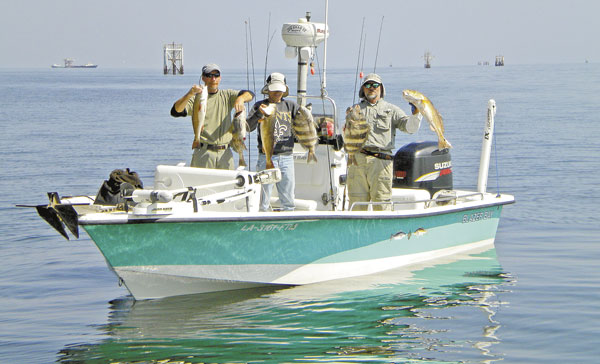
They’re big, they’re bad, and they’re biting right now!
March can be a challenging month for inshore anglers. It’s the one month of the year a psychiatrist would diagnose as bipolar. Or maybe they’d say it has identity issues, or commitment issues because March is fickle, and just can’t make up its mind whether it wants to be winter or spring.
The fact is, it has some of the attributes of both. That’s how March fools you. It pretends it wants to be spring, and sends some sunny, mild, spring-like days our way. Not too many at one time, but just enough to persuade us that winter is finally over. The tides will rise a bit, we’ll get reports of trout caught in some spring areas — but as soon as we decide to make a venture into the waters, it blasts us with a bone-chilling winter front that sends temperatures and water levels plunging.
I think March actually derives some sadistic pleasure by taunting us like that.
But we’re professional fishermen and we don’t use psychological terms when describing months and weather. We say, “March is a transition month,” which to us somehow sounds more knowledgeable and technical, as though we are privy to some mysterious information that commoners lack.
In reality, March is manic-depressive — cloudy, sunny, cold, warm, friendly and cruel, depending on its mood. And once you understand the nature of March, you’re much better equipped to deal with its whims.
Capt. Rory Rorison, of United Charters (504-439-1680) out of Shell Beach, says he copes with the fickleness of March by specifically targeting “reds and heads” in Breton Sound and Black Bay.
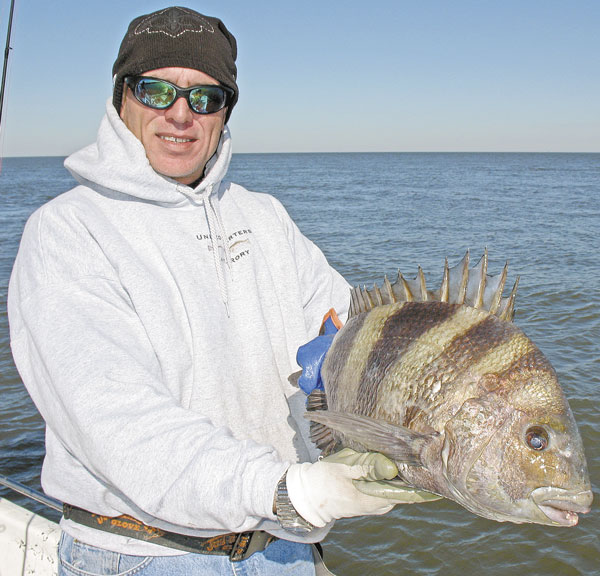 Rorison says trout action is hit-and-miss this month, so he improves his odds of a successful trip a thousandfold by heading outside to the deeper waters around the Central Rigs of Breton Sound, and fishes for big reds, big sheepshead and big black drum.
Rorison says trout action is hit-and-miss this month, so he improves his odds of a successful trip a thousandfold by heading outside to the deeper waters around the Central Rigs of Breton Sound, and fishes for big reds, big sheepshead and big black drum.
“The good bite out there actually begins in February and goes through April,” Rorison said, “so March is smack dab in the middle of the action.
“This is the month we specifically target these big fish and make the trek to the sound as they spawn. By April, we start switching gears and targeting speckled trout, so the time to chase reds and heads is now.”
Rorison invited me to hop aboard on a “reds n’ heads” trip to the Central Rigs with a couple of his long-time buddies: J.C. Fenascie, who works with the Louisiana Teen Challenge program, and Jason Kinler, a friend and co-worker.
We arrived at Rorison’s dock in Shell Beach to find the water levels so low the mud was exposed under his boat sling. Once we hopped aboard and added the weight of our gear, the problem was getting the big bay boat out of the slip into the deeper water of the canal. Once that was accomplished, we started up the Yscloskey Canal toward Campo’s Marina and bought some dead bait, then it was down the MRGO toward our destination.
Recent phenomenon
The extremely cold weather and the low water levels had an interesting side effect recently: It caused huge schools of redfish to travel up from Lake Borgne or the MRGO into Bayou Yscloskey, where they camped out for a few days just below the drawbridge. People who lined up along the bank and tossed dead shrimp, either under a cork or just on a plain jig head on the bottom, were instantly rewarded with a bent rod and stretched line.
Rorison said the action was so frenzied that many anglers were catching their limits using a piece of a rag for bait, and he limited out tossing a plain jig head!
I have to admit I was a bit jealous that I wasn’t down there to get in on some of that action. I have caught trout on rags before, and even on plain jig heads, but it was under the birds, and it was a long time ago. And if my memory is correct, they were mostly small fish.
But these were redfish, not trout, and they were not under the birds, and they weren’t small fish! Rorison said they averaged between 20 to 22 inches in size, with a few undersized fish and an occasional whopper thrown into the mix.
“Perfect eating-sized reds,” he said.
The fish went into the bayou when the water temperatures fell into the mid-to-low 40s, and once the weather moderated and the water temperatures and water levels came up, the reds moved out. Rorison said they made a second appearance in smaller numbers when similar conditions returned, but left just as soon as the conditions changed.
Robert Campo, over at Campo’s Marina in Shell Beach, said, “Apparently the new rock dam across the MRGO at Hopedale has altered the drainage dynamic all the way back at Shell Beach, and some interesting phenomena have resulted.
“The trout stacked up in the same bayou in between Lake Borgne and the MRGO just at the beginning of winter, and now the reds stacked up near the drawbridge in deep winter. It’ll be interesting to see what spring will bring!”
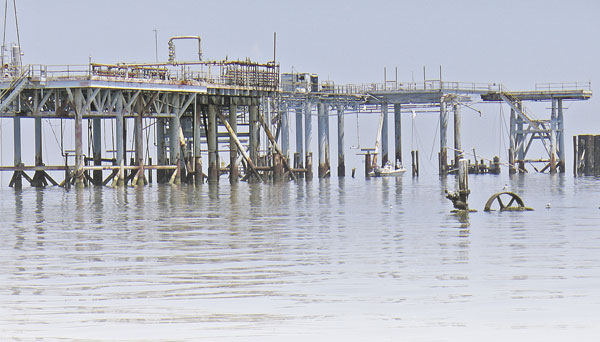
The tide was so low that Rorison decided against trying to run out the Spoil Canal, so he ran through Bayou LaLoutre instead. We traveled through Baker’s Canal, China Pass and Halfmoon Lake to Lake Eloi, and headed southeast toward Central. By the time this goes to press, water levels should be up enough to travel safely through the Spoil Canal, then out the MRGO east and south to Central.
Rorison pointed us toward the main Central Rig, but said the satellite rigs all around it will produce just as well.
“There’s a couple of good reasons why we like to head out to the sound for reds and heads this month,” he said. “First, the water can still be low in the marsh, and trout and reds inside can be tough to find.
“If it’s windy, the water is dirty, and if it’s calm the bugs are so bad you can’t stand it. At best your chances of a successful trip are iffy. But the sound is a virtual guarantee. If you can get out there, if the winds and seas allow you to take the trip, you will definitely catch fish. And not just a few, you’ll load the boat. The redfish are large and hungry, and the biggest challenge will be finding reds under 27 inches.
“The sheepshead are plentiful, large and hungry, and there’s no limit on them, so you can catch all you care to clean. You’re also likely to catch some black drum out there, and many of them should be the good-eating size, but there’ll be huge drum out there as well.
“I head to any of the taller structures around Central — 20, 21, 22, 28, 29 and Central itself,” he said. “Generally I’ll just hook on with a rig hook as close to the rig as is safe, and then fish straight down.
“The fish are either going to be on the bottom or suspended just off the bottom, and you’ll soon discover right where they are. I just use a plain jig head, either 3/8- or ½-ounce, depending on the current, with dead shrimp. No plastic bait is even necessary. Let your bait go all the way to the bottom, and it shouldn’t be long before you get some action.
“Sometimes they’re not directly on the bottom, but they’ll be suspended anywhere in between the surface to a foot or so off the bottom. When that’s the case, you’ll feel them peck at your bait as it’s on the way to the bottom, and you can adjust accordingly.”
Rorison said many of the Breton Sound and Black Bay structures will produce reds and heads this month.
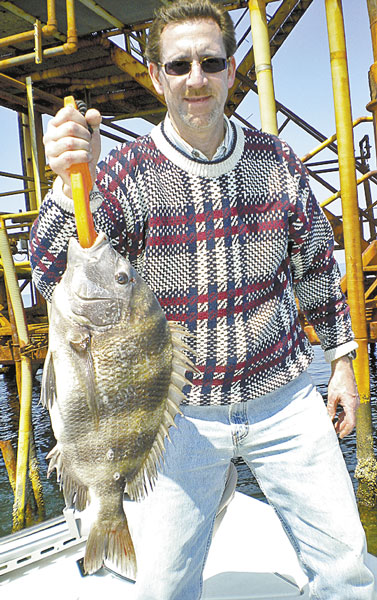
“The Five Wells, the Dope Boat, the Wreck and the rigs in deeper water in Black Bay will all have fish on them,” he said. “The key is to go to the deeper wells, those in at least 15 feet of water.
“You might catch some at the shallower rigs, but not nearly as many. They’ll be thick at those deeper rigs.”
And you don’t have to necessarily limit yourself to the large structures. Rorison said the smaller wells and structures also hold fish, but in general, the bigger concentrations of fish will be at the bigger rigs.
“If you hooked onto the rig and aren’t getting any hits, instead of moving to another rig, try moving upcurrent of the rig and anchoring so that you can fish toward the rig, and concentrate around the flowtubes,” he said. “I find the fish that way a lot of times, and we load up the boat.”
Rorison said you can expect a lot of snags and to lose a lot of jigs because the flowtubes and other debris clutters the bottom.
“That’s why I don’t bother tying Carolina rigs or drop-shot rigs because they’re just going to hang up and they’re more difficult to re-tie,” he said. “Just a plain jighead is all you need, and they’re not hard to tie.
“A lot of times when the action is fast and furious, I even flatten out the barbs on the jig head because it’s just so much easier to unhook them. As long as you keep the line tight, you really won’t lose the fish, and even if you do, there’s plenty more down there.
“I also recommend braided line, because you’re fishing up close to the structure and those fish are going to head right into it as soon as they realize they’re hooked. These are often big fish, and their scales and spines are sharp and abrasive and can easily pop a monofilament line.”
Overcoming negative conceptions
Targeting sheepshead these days is a lot like targeting reds in the old days — you have to overcome the negatives associated with them. They have a horrible name (who in their right mind wants to eat a sheep’s head?), they’re a nightmare to clean, you don’t get a whole lot of meat off of them and they’re only good for making fake crabmeat! But remember, just a short time ago, many anglers looked at redfish as a nuisance fish until we learned to prize it.
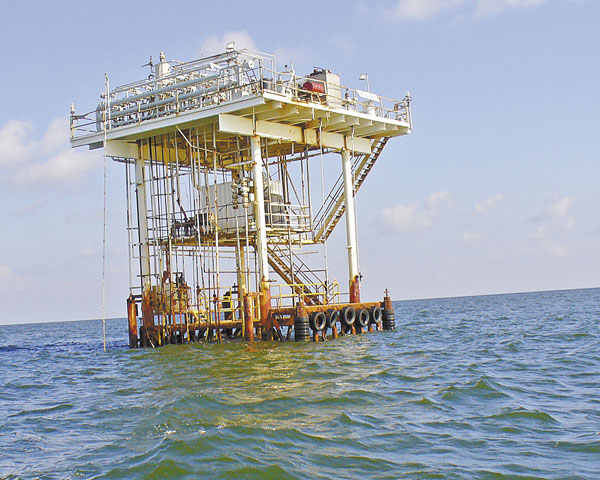
Rorison thinks we’ll come to prize sheepshead as well.
“As far as I’m concerned, I’ll choose eating sheepshead to trout anytime,” Rorison said. “I believe it’s the tastiest fish out there; it’s white meat, it has a firm texture and you can cook it any way you want to.
“It’s great fried, baked, broiled, grilled on the half-shell like you do redfish or blackened. People used to consider it a junk fish, and only used their meat as a faux crabmeat when you boiled it in cheesecloth with crab-boil. But more and more people are realizing just how good to eat these sheepshead are.”
Rorison likes them fried exactly like you’d fry trout, but he insists the sheepshead taste better.
And as for cleaning them, he says you do it exactly like you would a drum or redfish. He uses a regular, non-electric fillet knife. He says you can use an electric knife, but the fish are tough and they do take a toll on your knife.
“They also tear up your ice chest pretty good,” he said. “By May I’ll have to replace this ice chest, it’ll be so full of puncture holes from their sharp spines.”
I filet them with a big serrated knife, and I’m careful to steer clear of those long spiked spines. They are tough to clean, much tougher than trout, but I have to admit they are a blast to catch. And a trip to Black Bay or the sound is not much of a price to pay to have my line stretched and my rod doubled over.
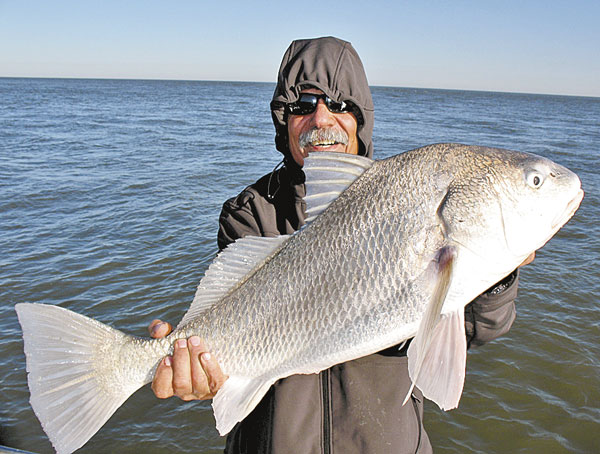
As for our trip, we parked the boat in one spot and caught some huge black drum, numerous sheepshead and several reds, mostly too large to keep. Unfortunately, we fished on one of those days that decided to act like winter, and it just never did warm up.
To make matters worse, the ride was rough because the seas were much higher than expected, and the winds kept building, so our stay was short-lived. But it felt good to work out with some hefty fish instead of barely keeper-sized trout, and to head back to the dock with a box full of fish.
And I came to a decision. I’m going to bring some people out here in March and April to catch some reds n’ heads in the sound — people who’ve never really caught fish before. I know if I bring them they’ll catch fish, they’ll catch big fish and they’ll catch plenty of fish.
You can’t offer a better introduction than that!
Captain Rory Rorison can be reached at (504) 439-1680.


